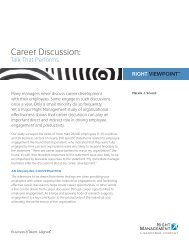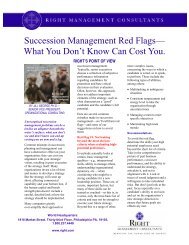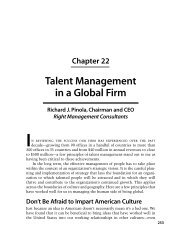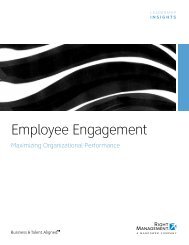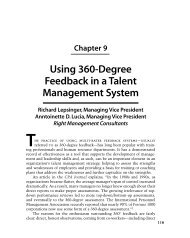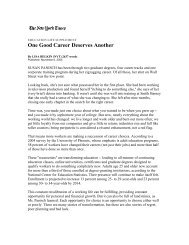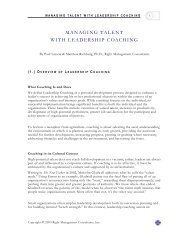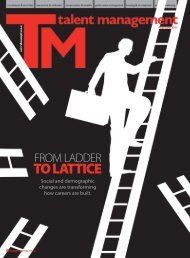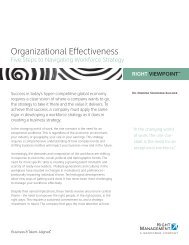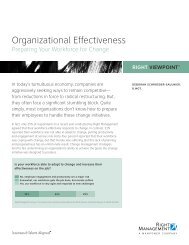Developing The Flexible Leader HQ.pub - Right Management
Developing The Flexible Leader HQ.pub - Right Management
Developing The Flexible Leader HQ.pub - Right Management
Create successful ePaper yourself
Turn your PDF publications into a flip-book with our unique Google optimized e-Paper software.
BY RICK LEPSINGER—MANAGING VICE PRESIDENT, ORGANIZATIONAL CONSULTING<br />
Rick’s new book, <strong>Flexible</strong><br />
<strong>Leader</strong>ship: Creating Value by<br />
Balancing Multiple Challenges<br />
and Choices , in collaboration<br />
with co-author Dr. Gary Yukl, is<br />
scheduled to be <strong>pub</strong>lished by<br />
Jossey-Bass/Pfeiffer in April<br />
2004.<br />
<strong>The</strong> book presents an integrated<br />
model of leadership—a coherent,<br />
consistent framework that<br />
provides a practical guide that<br />
leaders at all levels can use to enhance<br />
individual and<br />
organizational effectiveness.<br />
<strong>The</strong> following excerpts from the<br />
book help to illustrate this theme.<br />
Importance of <strong>Flexible</strong>,<br />
Adaptive <strong>Leader</strong>ship<br />
Talking about leadership in terms<br />
of what effective leaders do rather<br />
than what they are is a good<br />
beginning, but it not enough. If<br />
the assumption that leaders are<br />
born rather than made, and the<br />
assumption that leadership is<br />
provided only by those at the top,<br />
are dangerous, so is the<br />
assumption that certain leadership<br />
behaviors are equally appropriate<br />
and effective in all situations.<br />
Common sense alone should tell<br />
us that what works in one situation<br />
may be less effective in a different<br />
situation, or when circumstances<br />
change.<br />
<strong>Flexible</strong> <strong>Leader</strong>ship<br />
World Headquarters<br />
1818 Market Street, Thirty-third Floor<br />
Philadelphia, PA 19103<br />
215.988.1588 or 800.237.4448<br />
www.right.com<br />
For that reason, leaders at all<br />
levels need to develop the ability<br />
to determine just what challenge<br />
to focus on at any given time, and<br />
the best way to respond to it. . .<br />
Even for the same leadership<br />
challenge, the appropriate mix of<br />
leadership behaviors and formal<br />
programs will change as<br />
conditions change.<br />
A major difficulty for leaders is<br />
the need to balance the competing<br />
<strong>Right</strong> <strong>Management</strong><br />
Consultants is the<br />
world’s leading<br />
career transition<br />
and organizational<br />
consulting firm.<br />
and sometimes contradictory<br />
demands of the various<br />
leadership challenges. A leader<br />
who puts too much emphasis on<br />
efficiency and reliability may<br />
make adaptation more difficult to<br />
achieve and vice versa. An<br />
overemphasis on motivating<br />
employees may adversely affect<br />
operational efficiency, especially<br />
related to costs. <strong>Flexible</strong><br />
leadership requires skills in<br />
diagnosing the situation,<br />
evaluating the challenges,<br />
balancing competing demands,<br />
and integrating diverse<br />
leadership activities and<br />
programs in a way that is<br />
relevant for meeting the<br />
challenges.<br />
<strong>The</strong> Three <strong>Leader</strong>ship<br />
Challenges<br />
<strong>The</strong> effectiveness of an<br />
organization depends on three<br />
performance determinants<br />
identified earlier, which we<br />
have described as distinct<br />
leadership challenges.<br />
Efficiency and reliability<br />
involve using people and<br />
resources to carry out essential<br />
operations more effectively and<br />
in a way that minimizes cost,<br />
and establishing and maintaining<br />
standards of quality for the<br />
production and delivery of<br />
products and services (e.g.,<br />
avoiding unnecessary<br />
delays, errors, quality defects,<br />
or accidents). Adapting to the<br />
external environment involves<br />
responding in appropriate ways<br />
to threats and opportunities<br />
(e.g., changes in technology,<br />
moves of the competition,<br />
changes in customer needs and<br />
expectations), correcting<br />
internal weaknesses, and<br />
leveraging internal strengths.<br />
Human relations and resources<br />
involve ensuring that the<br />
organization has people with<br />
the skills and willingness to do<br />
their jobs effectively.
“Talking about<br />
leadership in terms of<br />
what effective leaders<br />
do rather than what<br />
they are is a good<br />
beginning, but it’s not<br />
enough”<br />
Three Types of <strong>Leader</strong>ship<br />
Activity<br />
<strong>The</strong> three types of leadership<br />
activity are differentiated by<br />
their primary objective—<br />
efficiency, adaptation, or human<br />
performance. Activities<br />
concerned primarily with<br />
improving efficiency and<br />
reliability include planning how<br />
to use personnel and resources to<br />
conduct operations, clarifying<br />
responsibilities and task<br />
objectives, monitoring<br />
operations and performance, and<br />
taking decisive action to identify<br />
and resolve problems that disrupt<br />
operations.<br />
Activities concerned primarily<br />
with adaptation include<br />
monitoring the external<br />
environment to identify threats<br />
and opportunities, strategic<br />
planning, initiating and leading<br />
change, encouraging innovative<br />
thinking, and facilitating<br />
collective learning. Activities<br />
concerned with human relations<br />
and resources include developing<br />
individual skills and<br />
confidence, providing<br />
recognition for contributions<br />
and achievements, involving<br />
people in decisions that affect<br />
them, empowering people to do<br />
their work better, and providing<br />
the support needed to make the<br />
job satisfying to people.<br />
All three types of leader activity<br />
are necessary for the success of<br />
an organization, but their<br />
degree of importance will vary<br />
depending on which challenge<br />
is most prominent at a given<br />
time. <strong>The</strong> relevance of each<br />
behavior also depends on other<br />
aspects of the leadership<br />
situation, including the type of<br />
leadership position. For<br />
example, the change-oriented<br />
behaviors are often more<br />
relevant for higher-level leaders<br />
than for lower-level leaders. . .<br />
Formal Programs Affecting<br />
Each Challenge<br />
<strong>The</strong> leadership activities<br />
provide one important way to<br />
meet the three types of<br />
challenges. In addition, there<br />
are many types of formal programs<br />
that can potentially result<br />
in improved performance for an<br />
organization. Business process<br />
improvement, reengineering,<br />
Six Sigma programs,<br />
downsizing, and outsourcing<br />
are examples of programs used<br />
to improve efficiency or<br />
reliability. Knowledge<br />
management, entrepreneurship,<br />
benchmarking, and market<br />
To learn how <strong>Right</strong> can help you develop your<br />
leaders of tomorrow, order your free copy of<br />
<strong>Right</strong>’s <strong>Developing</strong> <strong>Leader</strong>s by calling<br />
1-800-720-2354 and reference reply code G43<br />
today or contact your local <strong>Right</strong> office.<br />
2<br />
research programs are used to<br />
increase innovation,<br />
organizational learning, and<br />
adaptation to the<br />
environment. Quality of<br />
work life programs, employee<br />
development programs,<br />
employee assessment<br />
systems, talent management<br />
systems, and compensation<br />
systems are used to increase<br />
employee skills or<br />
commitment. CEOs and<br />
leaders of major subunits<br />
often have the authority to<br />
implement such programs,<br />
although low-level leaders<br />
seldom have this option.<br />
Like the specific types of<br />
leadership activities, these<br />
formal programs are likely to<br />
have consequences for more<br />
than one type of performance<br />
determinant. Some programs<br />
may improve more than one<br />
performance determinant<br />
simultaneously. For<br />
example, a well- designed<br />
incentive system may<br />
improve reliability,<br />
innovation, and employee<br />
satisfaction simultaneously.<br />
However, some programs<br />
designed to deal with one<br />
challenge have adverse<br />
effects for another challenge.<br />
For example, downsizing<br />
programs may improve<br />
efficiency at the expense of<br />
employee satisfaction and<br />
commitment. Ensuring that<br />
different programs are<br />
mutually compatible is<br />
another challenge facing toplevel<br />
leaders in organizations.



